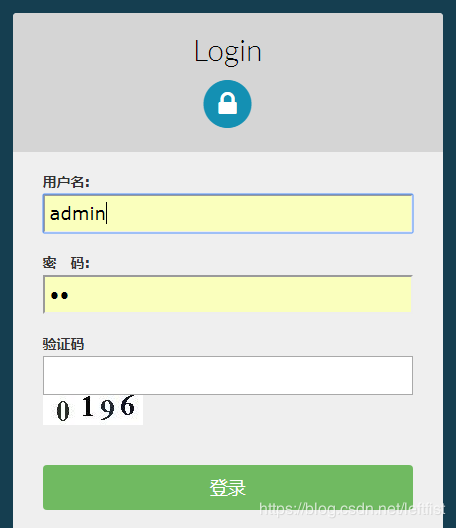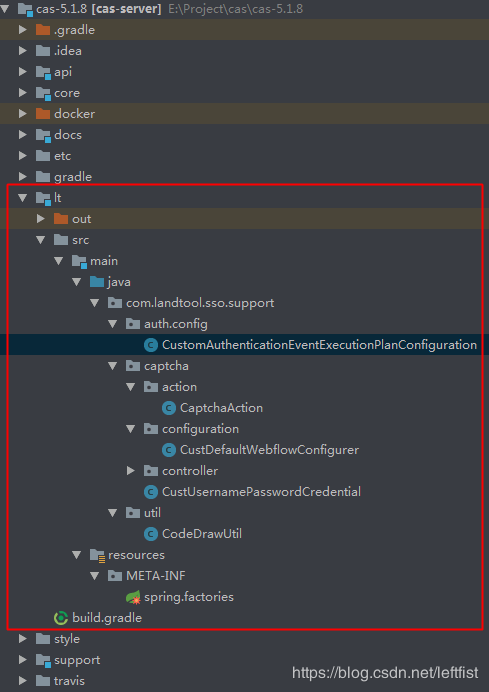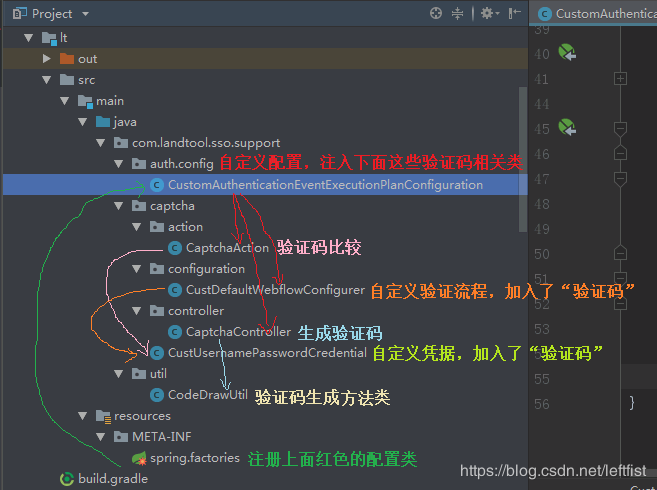CAS5.1.8添加验证码
版权声明:本文为博主原屙文章,喜欢你就担走。 https://blog.csdn.net/leftfist/article/details/84790650
老生常谈的题目了吧。但是,要在网上找出一篇能跑又看得明白的相关教程,还真不容易。
我费了九牛二虎之力,终于添加了验证码功能,记录如下。
一、运行结果

二、代码结构
代码是纯添加的,不想修改现有的代码。CAS实在是太庞大了,idea添加都要几分钟。作为一个java小白,基本看不懂里面的代码,搞不清里面的结构,怎么改?能不动就不动,可以动也不动,打死都不动。
新加的代码,就在“lt”这个目录里,如图所示。

三、代码讲解
代码呢,基本也是抄过来的(源码好像是在这里),我也不大懂,所以只能按照自己的理解说一下,说错勿怪。
代码文件职责以及调用关系。

梳理一下,从上到下:
1、在spring.factories里注册自定义配置类
org.springframework.boot.autoconfigure.EnableAutoConfiguration=/ com.landtool.sso.support.auth.config.CustomAuthenticationEventExecutionPlanConfiguration
2、自定义配置类里负责将生成验证码、验证流程、验证码比较类注入
@Bean
public CaptchaController captchaController(){
return new CaptchaController();
}
@Bean
public CaptchaAction captchaAction(){
return new CaptchaAction();
}
@Bean
@Order(1)
public CasWebflowConfigurer defaultWebflowConfigurer() {
final CustDefaultWebflowConfigurer c = new CustDefaultWebflowConfigurer(flowBuilderServices, loginFlowDefinitionRegistry);
return c;
}
3、验证码比较和流程,需要用到自定义凭据
凭据里存储了验证码,然后验证的时候,读取这个凭据。凭据一直都有,默认的,但没有验证码。这里重载了凭据类,将验证码加了进去。然后又重载了流程,流程里引用了凭据。
自定义凭据CustUsernamePasswordCredential
public class CustUsernamePasswordCredential extends UsernamePasswordCredential {
private static final long serialVersionUID = 1767227441947916650L;
private String captcha;
public CustUsernamePasswordCredential() {
}
public CustUsernamePasswordCredential(String userName, String password, String captcha) {
super(userName, password);
this.captcha = captcha;
}
public String getCaptcha() {
return captcha;
}
public void setCaptcha(String captcha) {
this.captcha = captcha;
}
@Override
public boolean equals(Object o) {
if (this == o) return true;
if (!(o instanceof CustUsernamePasswordCredential)) return false;
if (!super.equals(o)) return false;
CustUsernamePasswordCredential that = (CustUsernamePasswordCredential) o;
return Objects.equals(getCaptcha(), that.getCaptcha());
}
@Override
public int hashCode() {
return Objects.hash(super.hashCode(), getCaptcha());
}
}
自定义流程
/**
* 参考 {@link org.apereo.cas.web.flow.DefaultWebflowConfigurer}
*/
public class CustDefaultWebflowConfigurer extends DefaultWebflowConfigurer {
public CustDefaultWebflowConfigurer(FlowBuilderServices flowBuilderServices,
FlowDefinitionRegistry flowDefinitionRegistry) {
super(flowBuilderServices, flowDefinitionRegistry);
}
/**
* 重写 {@link org.apereo.cas.web.flow.DefaultWebflowConfigurer} 的方法
*
* Create remember me authn webflow config.
*
* @param flow the flow
*/
protected void createRememberMeAuthnWebflowConfig(final Flow flow) {
/**
*用我们拓展CustUsernamePasswordCredential来替换原来的
* {@link org.apereo.cas.authentication.UsernamePasswordCredential}
*/
super.createFlowVariable(flow, CasWebflowConstants.VAR_ID_CREDENTIAL, CustUsernamePasswordCredential.class);
}
}
验证“验证码“CaptchaAction.java
@Override
protected Event doExecute(RequestContext context) throws Exception {
HttpServletResponse response = (HttpServletResponse) context.getExternalContext().getNativeResponse();
HttpServletRequest request = (HttpServletRequest) context.getExternalContext().getNativeRequest();
HttpSession session = request.getSession();
String captchaKey = (String) session.getAttribute(CAPTCHA_KEY);
if(null == captchaKey){
LOGGER.error("验证码验证异常");
return this.getError(context,CUSTOM_CAPTCHA_FAIL_EXCEPTION);
}
//凭据--------------------
CustUsernamePasswordCredential credential = (CustUsernamePasswordCredential) WebUtils.getCredential(context);
if(null == credential || (null == credential.getCaptcha() || "".equals(credential.getCaptcha().trim()))){
LOGGER.error("请输入验证码");
return this.getError(context,CUSTOM_CAPTCHA_FAIL_ERROR);
}
String requestCaptcha = credential.getCaptcha();
if(!captchaKey.toLowerCase().equals(requestCaptcha.toLowerCase())){
LOGGER.error("验证码错误");
return this.getError(context,CUSTOM_CAPTCHA_FAIL_ERROR);
}
return super.success();
}
4、前端访问的是控制器"生成验证码"
/webapp/resources/templates/fragments/loginform.html
<section class="row">
<label for="captcha" th:utext="#{screen.welcome.label.captcha}"/>
<div>
<input class="required"
type="text"
id="captcha"
name="captcha"
size="25"
tabindex="2"
autocomplete="off"/>
<img th:src="@{/captcha/get}"/>
</div>
</section>
可以发现,其中的 核心是配置类 : CustomAuthenticationEventExecutionPlanConfiguration (为什么要这么长,装逼吧),它负责组织、注入各种实例。里面的这些神秘字眼“ @Bean ”呀,“ @Autowired ”呀,称之为注解。感觉跟C#里的Attitude(特性)差不多,声明一下,Spring容器就知道该干什么了。小字眼,做大事。
完整的LT代码











![[HBLOG]公众号](https://www.liuhaihua.cn/img/qrcode_gzh.jpg)

